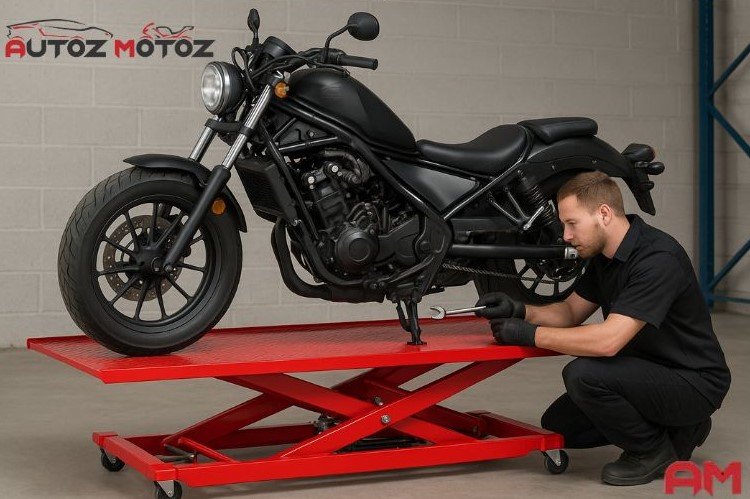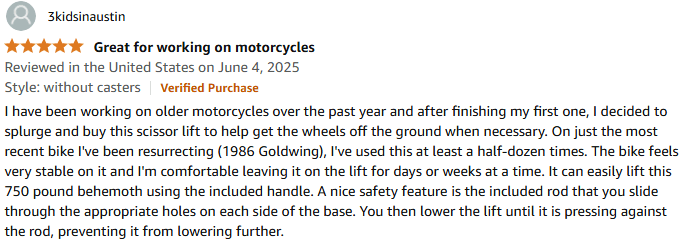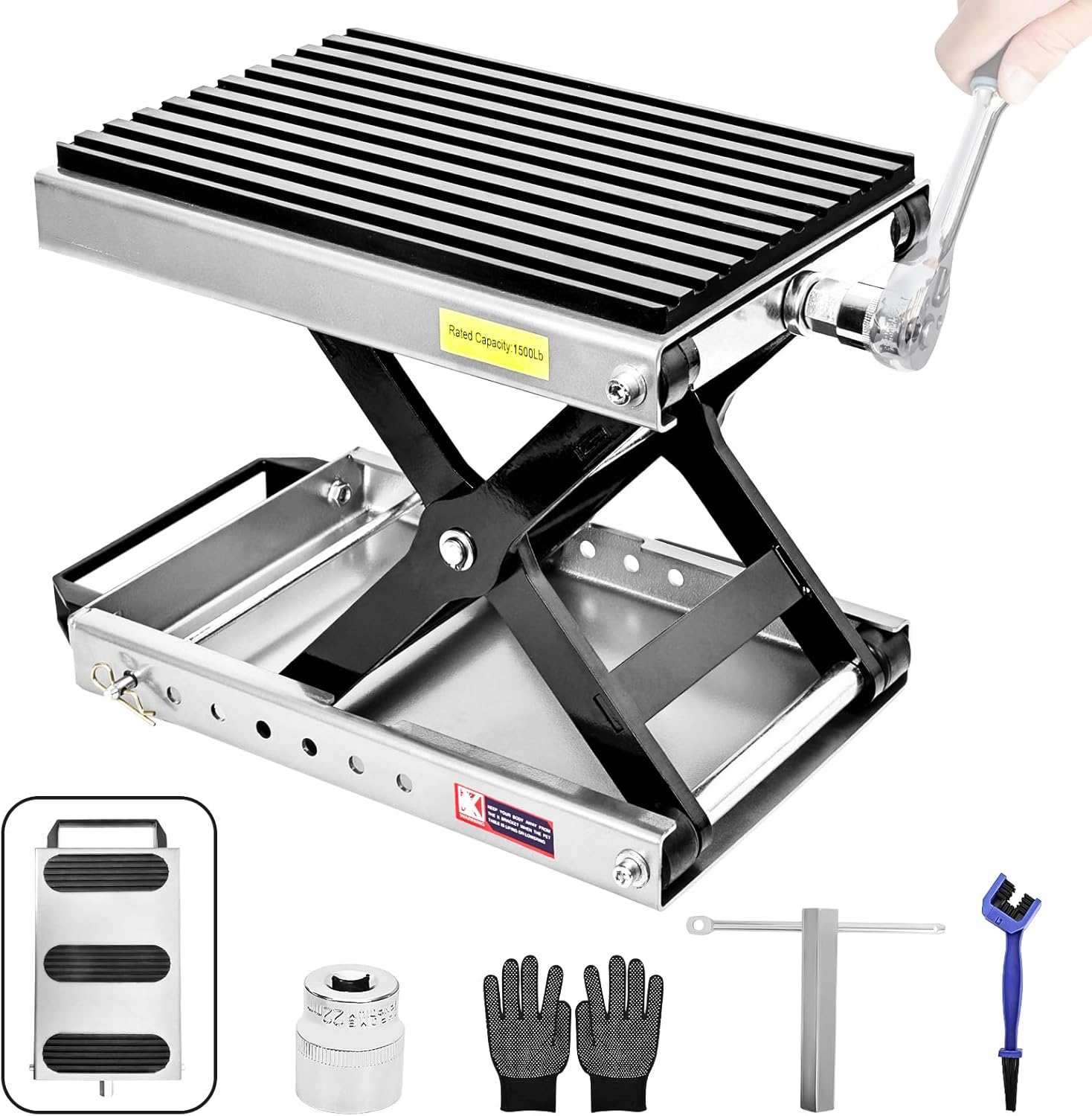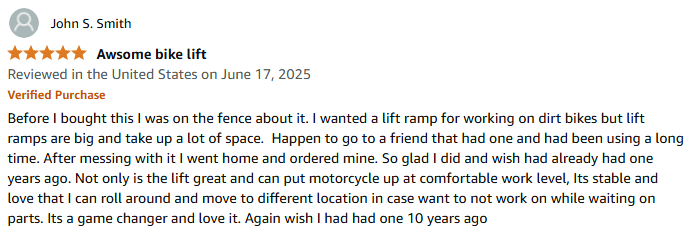No matter! Whether you’re a professional mechanic or a passionate rider who loves to maintain their bike at home, safety during lifting is paramount. A reliable motorcycle floor jack isn’t just about making repairs easier — it’s about protecting you and your motorcycle from accidents and damage. Choosing the best jack that ensures safe lifting can make all the difference in your workshop or garage.
Motorcycle floor jacks come in various designs, capacities, and features, but not all offer the same level of stability and security. A quality floor jack should provide strong support, prevent slipping, and offer smooth lifting and lowering controls. Features like a sturdy steel frame, wide lifting platforms with non-slip surfaces, and secure locking mechanisms are essential to prevent accidents while working under your bike.
Sort out the right floor jack, consider the weight capacity to ensure it can handle your motorcycle’s weight safely. Many jacks offer hydraulic lifting systems, which provide precise control and reduce the effort needed to raise your bike, enhancing safety and convenience. Additionally, portability and ease of use can make maintenance tasks quicker and less stressful.
In this article, certainly we’ll explore the top bike floor jacks that combine power, durability, and safety features. From compact scissor jacks to heavy-duty hydraulic lifts, we’ll help you find a floor jack that meets your needs while prioritizing your safety. Read on to discover the best tools to keep your bike secure and make your maintenance tasks safer and more efficient.
Why Jack lift is Important tool for Motorcycle
If you’re a home mechanic, weekend rider, or even a seasoned technician, having a motorcycle floor jack in your garage is a game-changer. It’s not just about convenience—it’s about working smarter and safer every time you reach for a wrench. Unlike standard stands, a quality motorcycle floor jack provides balanced lifting, giving full access to the underside of your bike—without the danger of tipping or shifting.
When it comes to motorcycle maintenance, having the right floor jack is essential—not just for convenience but for your safety. The best motorcycle floor jack combines several key features, including lift height, weight, build quality, portability, non-slip design, capacity, and hydraulic performance, to ensure safe and efficient lifting every time.
Moreover, regular repairs such as oil changes, brake inspections, and chain adjustments become far easier when your bike is elevated securely. Not only does this tool improve comfort while working, but it also minimizes the risk of injury or bike damage during servicing.
In addition, the right jack reduces physical strain. You no longer need to crouch or work at awkward angles, which is especially helpful during longer maintenance tasks. The ability to lift your motorcycle quickly and hold it steadily at various heights allows for more precise and confident work.
Some Parameters or key features-consider the Efficiency of a jack
Selecting a motorcycle floor jack with these features ensures your bike maintenance is safe, efficient, and stress-free.
Lift Height is crucial because it determines how high your bike can be raised for comfortable access to the underside. A good motorcycle floor jack should offer adjustable height settings, typically ranging from a low starting point for easy placement to a high enough lift for comprehensive repairs. This flexibility helps prevent strain and makes maintenance safer.
Weight of the jack itself affects ease of handling. While a heavier jack often means sturdier construction, it can be cumbersome to move. The ideal balance is a jack that is robust yet portable enough to carry or store without hassle. Many modern jacks come with built-in handles or wheels, enhancing their portability.
Build Quality directly impacts durability and safety. Look for jacks made of high-grade steel or carbon steel with corrosion-resistant finishes. This ensures the jack withstands heavy use without bending or failing. A solid, well-constructed jack gives you peace of mind that your motorcycle will remain stable during lifts.
Non-slip surfaces and safety locks are vital to prevent the bike from slipping or shifting during lifting.
Capacity is another critical factor—choose a floor jack with a weight rating exceeding your motorcycle’s weight. Most quality jacks support capacities from 1000 lbs up to 1500 lbs or more, catering to a wide range of bikes.
Finally, hydraulic systems offer smooth, controlled lifting with minimal effort, boosting both safety and ease of use. Hydraulic jacks provide steady pressure and precise control during raising and lowering, preventing sudden drops.
Merits of a Motorcycle Jack - Performance Analysis
At the time of evaluating the overall performance of a lift, several key benefits stand out that directly enhance both safety and efficiency in maintenance tasks. First and foremost, a quality jack delivers consistent lifting power, allowing riders and mechanics to access hard-to-reach areas without strain or imbalance. Whether you’re performing an oil change, adjusting the chain, or replacing tires, a steady lift ensures your motorcycle remains firmly supported throughout the process.
Into the bargain – for the stability of motorcycle jacks are designed to accommodate various models and frame sizes, making them incredibly versatile. Thanks to adjustable height ranges, you can lift your bike just high enough for minor inspections or much higher for more involved repairs. This flexibility not only improves convenience but also reduces physical effort, especially when combined with smooth-operating hydraulic systems or easy-to-turn screw mechanisms.
Furthermore, non-slip deck surfaces or rubberized pads provide an added layer of safety. These features reduce the chance of frame damage and help keep the bike from sliding during elevation. That means you can work with confidence, knowing the motorcycle is securely positioned.
Another merit worth noting is portability. Many jacks are designed with compact dimensions and lightweight frames, which makes them easy to store or move as needed. Some models even include built-in handles or caster wheels for added mobility around the garage.
Moreover, high-quality materials such as reinforced steel or powder-coated finishes contribute to long-term durability. As a result, a reliable jack doesn’t just perform well—it maintains that performance over years of use.
In short, the combination of strength, safety, adaptability, and durability makes a good motorcycle jack an essential tool for anyone who values secure and efficient bike maintenance.
Top 7 Products to Consider in 2025 : Review and Purchase
• High 1500 lb capacity
• Wide lift range (4.7″–15″)
• Stable with rubber pad + straps
• Foot-operated hydraulic lift
• Durable steel build
• Easy to move (wheels)
• Safety lock bar
• Needs some assembly
• Takes up space
• Heavy (60+ lbs)
• Needs some assembly
• Occasional weld issues
• Takes up space
Disclosure: This post contains affiliate links.
Reference: Amazon.com
2
• 1100 lb capacity
• Lightweight (~30 lbs)
• Durable steel frame
• Non-slip rubber top
• Compact & easy to store
• No hydraulic maintenance
• No hydraulic lift (manual crank)
• Lower max height
• Slower to operate
• Not ideal for large bikes
Disclosure: This post contains affiliate links.
Height: ~3.7″–13.8″ (some variants up to ~15.7″)
Weight: ~28–30 lbs
Build: Steel X‑frame; powder‑coated; stiff & durable
Portability: Foldable, wheeled base, easy to roll
Non‑Slip: Rubber deck or saddles for grip & bike protection
Capacity: 1100 lbs
Lifting: Hand-crank operation (no hydraulic pump)
Reference: Amazon.com
3
• 1500 lb capacity
•Thick non-slip rubber pad
•Compact and easy to carry
•Durable steel build
•Smooth manual screw lift
Disclosure: This post contains affiliate links.
5
• Strong 500 lb capacity
• Durable steel build
• Easy to move with wheels
• Secure, rubber-padded grips
Disclosure: This post contains affiliate links.
Reference: Amazon.com
6
Strong 1100 lb capacity
Durable steel build
Compact and easy to store
Wide deck for better stability
No hydraulic lift (manual only)
No rubber pad (less grip)
Slower to operate
Disclosure: This post contains affiliate links.
Reference: Amazon.com
7
• Strong 1400 lb capacity
• Durable, rust-resistant
• Portable handle
• Stable rubber pad
See More for Exploring
Disclosure: This post contains affiliate links.

Reference: Amazon.com
Setup Process: Preparing Your Motorcycle Floor Jack for Safe Use
Servicing is a regular fellow for any bike and as a user you are always welcome to take care of your fabourite motorcycle fitness. So it is almost mendatory a jack to lift your bike smoothly and tension free.
- Avoid uneven or sloped areas, as they may compromise balance during lifting, before you begin lifting your motorcycle, proper setup of your floor jack is critical to ensure both performance and safety.
- Afterward , check that the jack is fully retracted before positioning it under the bike. For scissor jacks or hydraulic models, this means ensuring the lifting platform is at its lowest point. Identify the correct lifting points on your motorcycle — typically beneath the engine or frame — to avoid damaging exhaust pipes or the oil pan.
- Slide the jack under the motorcycle and align the rubberized or non-slip pad directly beneath the lifting point. This provides grip and prevents the bike from sliding as it lifts. Once aligned, apply the crank handle or operate the foot pedal (for hydraulic models) slowly to raise the platform. Always lift gradually and check balance frequently.
- Use safety locks or locking bars if available to secure the height once lifted. Some floor jacks include built-in locking mechanisms or may pair with jack stands for additional security.
- Proper setup ensures not just ease of maintenance but also minimizes the risk of injury. Taking a few extra minutes to follow safe lifting protocols will prolong the life of both your jack and your motorcycle — and give you confidence in every repair or inspection task you undertake.
Integration Instructions: Step-by-Step Guide
- Inside the box, you’ll typically find the main frame, lifting platform, handle, wrench or pedal, and mounting hardware. Most floor jacks come partially assembled, requiring just a few simple steps to complete the setup. Before you start, read the user manual carefully — it usually provides model-specific safety notes and torque specifications.
- Begin by attaching the handle or crank system. For scissor jacks, this involves securing the crank handle to the side screw mechanism using the included bolts or clips. In hydraulic models, connect the foot pedal or lever to the hydraulic piston according to the manual. Ensure all moving parts are secure but not overtightened.
- Make sure the pad is centered and firmly attached, as this will support the motorcycle’s weight directly. Some platforms are adjustable in width or length—set this based on your bike’s frame size. Install the lifting platform or rubber pad. Many models use a bolted-on top pad for anti-slip grip.
- If the jack has wheels, ensure they rotate freely and lock properly. This allows easier positioning before lifting and stability once the jack is in place.Once assembled, test the jack with no load. Raise and lower the platform to confirm smooth motion, check for leaks (in hydraulic models), and listen for any odd noises.
- As a matter of fact, Assembly typically takes 10–20 minutes, even for beginners. With everything in place, your jack is now ready for safe and secure lifting, giving you the peace of mind to focus on your motorcycle, not the equipment holding it up.
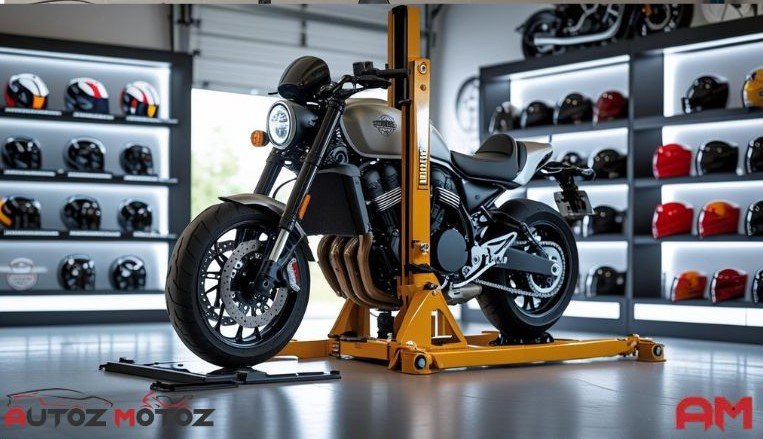
Safety Features of a Motorcycle Jack
This section is a top priority when we need a tool for our motorcycle to manage the service hassle-free; then the main role player is the “motorcycle jack”—whether for routine maintenance or complex repairs. A high-quality motorcycle jack offers more than lifting strength—it incorporates essential features that protect both the user and the bike. These built-in safeguards reduce the risk of accidents, slips, and structural damage, ensuring peace of mind during every task.
Key Safety Features:
- Secure Locking Mechanism – Holds the jack at a fixed height to prevent accidental lowering.
- Textured or Rubberized Pads – Minimizes slippage and protects the bike’s frame
- Wide, Stable Base -Increases balance and reduces the chance of tipping
- Hydraulic Models – Prevents lifting beyond rated capacity
- Controlled Lowering Function – Ensures smooth, gradual descent
- Manual Crank or Pedal Operation – Offers better precision and control
- Reinforced Steel Construction – Maintains structural integrity under stress
Why These Features Matter
Case in point, a locking mechanism ensures the jack remains stable at your chosen height, allowing you to work without fear of collapse. Non-slip surfaces, often made of textured rubber, help grip the motorcycle securely, especially during adjustments or tire changes.
Moreover, a wide base distributes weight evenly, enhancing stability—an essential feature when working on uneven garage floors or with heavier motorcycles. In hydraulic models, overload protection valves add an extra layer of security by preventing unsafe pressure buildup.
Ultimately, a motorcycle jack with the right safety features isn’t just convenient—it’s critical. Choosing a jack built for safety ensures your maintenance routine stays effective, efficient, and above all, secure.
Comparison Study for Jack lift in Real Market
- Ultimate Motorcycle Support: Effortlessly lift motorcycles weighing up to 1100 lb. with this ready-to-use motorcycle scissor jack from Orion Motor Tech, ensuring easy maintenance for your cruisers, dirt bikes, and other motorcycles
- Enjoy Effortless Lifting: With a simple turn of the included T-handle or using the 3/8″ socket and ratchet wrench, effortlessly lift your motorcycle from 3.7″ to 14.6″. This makes it easy to perform repairs comfortably at the ideal height
- Safe and Stable Operation: The 9.1″x14.6″ wide deck on our motorcycle jack stand offers a stable and spacious platform for your motorcycle, preventing it from tipping or shifting while it is lifted or lowered
- Designed for Heavy Use: Made of heavy-duty steel, our motorcycle lift stand provides superior strength and long-lasting corrosion resistance. Plus, the rubber tabletop securely holds your motorcycle in place at all times
- Enhanced Strength: The plug welding and double crossbar design on this motorcycle table lift ensures a strong and durable construction, with seamless joints that enhance the overall appearance and performance
Material: 1045 Carbon Steel, Rubber, CR-V, Plastic
Color: Gray
Lifting Range: 3.7-13.8 in. (9.5-35 cm)
Optimal Height: 13.4 in. (34 cm)
Deck Dimensions: 9.1 x 14.6 in. (23 x 37 cm)
T-Handle Length: 6.2 in. (15.7 cm)
Rubber Pad Dimensions: 14.1 x 8.5 in. (35.7 x 21.7 cm)
Max. Load Capacity: 1100 lb. (500 kg)
Net Weight: 28.1 lb. (12.8 kg)
Yes
referenced by : orionmotortech.com
Conclusion & Decision: Choosing the Right One
A quality jack offers more than functionality—it adds confidence to every lift. Models with reinforced steel construction and wide platforms provide maximum stability, while non-slip pads help protect your bike’s frame. Furthermore, adjustable height settings make it easier to access hard-to-reach components, whether you’re performing basic oil changes or more advanced repairs.
Selecting the ideal motorcycle jack is not just about lifting a bike-it’s about making your maintenance process safer, faster, and more reliable. With many options on the market, your final decision should consider the jack’s build quality, lifting range, safety features, weight capacity, and whether you prefer manual or hydraulic operation.
Additionally, portability plays a key role, especially for those with limited garage space. Lightweight, compact jacks are easier to store and maneuver without compromising safety. On the other hand, heavier-duty models may take up more room but offer higher lifting power and greater durability.
A good deal of, a hydraulic jack delivers smooth, effortless lifting—ideal for frequent use. However, manual scissor jacks remain a budget-friendly and dependable choice for occasional riders or DIY enthusiasts.Ultimately, the best motorcycle jack is the one that fits your bike, your workspace, and your needs.
Quick Decision Tips:
- Choose hydraulic for easier, faster lifting
- Go manual for affordability and simplicity
- Prioritize safety locks and non-slip features
- Match weight capacity to your bike’s specs
- Consider portability for easy storage
Frequently Asked Questions
The safest jack combines a low starting height, stable steel frame, and lockable lift position—ideal for steady, secure lifting without wobble.
Most support 500–1500 lbs. Pick one that exceeds your bike’s weight.
Standard range is 3″ to 15″, enough for most maintenance tasks.
Yes, they prevent slipping and protect the bike frame.
Hydraulic for ease, manual for simplicity and price.
No. Most need minimal or no assembly – just plug and use.
Fits most—check your bike’s frame and ground clearance.
Yes, many models are compact and garage-friendly.
Not all—prioritize models with locking bars or pins.
Definitely. A good jack improves safety, speed, and serviceability.Definitely. A good jack improves safety, speed, and serviceability.

